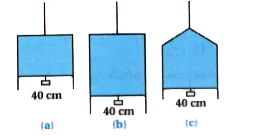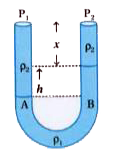SECTION - B Numerical From Textual Exercise from KUMAR PRAKASHAN KENDRA PHYSICS (GUJRATI ENGLISH) MECHANICAL PROPERTIES OF FLUIDS for Class 11
| Class 11 | PHYSICS |
| Chapter | MECHANICAL PROPERTIES OF FLUIDS |
| KUMAR PRAKASHAN KENDRA PHYSICS (GUJRATI ENGLISH) | SECTION - B Numerical From Textual Exercise |
| Medium | English |
| Academic Year | 2023-2024 |
Question 1
A 14.5 kg mass, fastened to the end of a steel wire of unstretched 1.0 m, is whirled in a vertical circle with an angular velocity of 2 rev/s at the bottom of the circle. The cross- sectional area of the wire is 0.065 cm2. Calculate the elongation of the wire when the mass is at the lowest point of its path. View SolutionQuestion 4
At a depth of 1000 m in an ocean (a) What is the absolute pressure ? (b) What is the gauge pressure ? © Find the force acting on the window of area 20cm×20cm of a submarine at this depth the interior of which is maintained at sea level atmospheric pressure. (the density of sea water =1.03×103×103kgm−3,g=10ms−2)View SolutionQuestion 5
Two syringes of different cross sections (without needles)filled with water are connected with a tightly fitted rubber tube filled with water .Diameters of the smaller piston and larger piston 1.0 cm and 3.0 cm respectively .(a)Find the force exerted on the large piston when a force of 10 N is applied to the smaller piston .(b) If the smaller piston is pushed in through 6.0 cm how much does the larger piston move out ?View SolutionQuestion 6
In a car lift compressed air exerts a force F1 on a small piston having a radius of 5.0 cm . This pressure is transmitted to a second piston of radius 15 cm . (See figure).If the mass of the car to be lifted is 1350kg .Calculate F1 . What is the pressure necessary to accomplish this task ? (g=9.8ms−2)
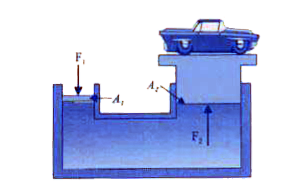 View Solution
View SolutionQuestion 7
The flow of blood in large artery of anesthetised dog is diverted through a venturi meter . The wider part of the meter has a cross sectional area equal to that of the artery.
A=8mm2 . The narrower part has an area
a=4mm2. The narrower part has an area a=4mm2. The pressure drop in the artery is 24 Pa . What is the speed of the blood in the artery ? (1.60×103kgm−3)View SolutionQuestion 8
A fully loaded boeing aircraft has a mass of 3.3×105kg . Its total wing area is 500m2 .It is in level flight with a speed of 96.km/h.
(a) Estimate the pressure difference between the lower and upper surfaces of the wings .
(b) Estimate the fractional increase in the speed of the air on the upper surface of the wing relative to the lower surface. (The density of air is ρ=1.2kgm−3)(g=9.8ms−2)View SolutionQuestion 9
A metal block of area 0.10m2 is connected to a 0.010kg mass via a string that passes over an ideal pulley (considered massless and frictionless) as in figure . A liquid with a film thickness of 0.30mm is placed between the block and the right with a constant speed of 0.085ms−1 . Find the coefficient of viscosity of the liquid.
 View Solution
View SolutionQuestion 12
The lower end of a capillary tube of diameter 2.00 mm is dipped 8.00 cm below the surface of water in a beaker . What is the pressure required in the tube in order to blow a hemispherical bubble at the end in water ? The surface tension of water at temperature of the experiments is 7.30×10−2Nm9−1.
1 atmospheric pressure =1.01×105Pa.
Density of water =1000kg/m3,g=9.80ms−2.
Also calulate the excess pressure .View SolutionQuestion 17
At a depth of 1000 m in an ocean (a) What is the absolute pressure ? (b) What is the gauge pressure ? © Find the force acting on the window of area 20cm×20cm of a submarine at this depth the interior of which is maintained at sea level atmospheric pressure. (the density of sea water =1.03×103×103kgm−3,g=10ms−2)View SolutionQuestion 18
At a depth of 1000 m in an ocean (a) What is the absolute pressure ? (b) What is the gauge pressure ? © Find the force acting on the window of area 20cm×20cm of a submarine at this depth the interior of which is maintained at sea level atmospheric pressure. (the density of sea water =1.03×103×103kgm−3,g=10ms−2)View SolutionQuestion 19
Two syringes of different cross sections (without needles)filled with water are connected with a tightly fitted rubber tube filled with water .Diameters of the smaller piston and larger piston 1.0 cm and 3.0 cm respectively .(a)Find the force exerted on the large piston when a force of 10 N is applied to the smaller piston .(b) If the smaller piston is pushed in through 6.0 cm how much does the larger piston move out ?View SolutionQuestion 20
In a car lift compressed air exerts a force F1 on a small piston having a radius of 5.0 cm . This pressure is transmitted to a second piston of radius 15 cm . (See figure).If the mass of the car to be lifted is 1350kg .Calculate F1 . What is the pressure necessary to accomplish this task ? (g=9.8ms−2)
 View Solution
View SolutionQuestion 21
In a car lift compressed air exerts a force F1 on a small piston having a radius of 5.0 cm . This pressure is transmitted to a second piston of radius 15 cm . (See figure).If the mass of the car to be lifted is 1350kg .Calculate F1 . What is the pressure necessary to accomplish this task ? (g=9.8ms−2)
 View Solution
View SolutionQuestion 22
The flow of blood in large artery of anesthetised dog is diverted through a venturi meter . The wider part of the meter has a cross sectional area equal to that of the artery.
A=8mm2 . The narrower part has an area
a=4mm2. The narrower part has an area a=4mm2. The pressure drop in the artery is 24 Pa . What is the speed of the blood in the artery ? (1.60×103kgm−3)View SolutionQuestion 23
The flow of blood in large artery of anesthetised dog is diverted through a venturi meter . The wider part of the meter has a cross sectional area equal to that of the artery.
A=8mm2 . The narrower part has an area
a=4mm2. The narrower part has an area a=4mm2. The pressure drop in the artery is 24 Pa . What is the speed of the blood in the artery ? (1.60×103kgm−3)View SolutionQuestion 24
A fully loaded boeing aircraft has a mass of 3.3×105kg . Its total wing area is 500m2 .It is in level flight with a speed of 96.km/h.
(a) Estimate the pressure difference between the lower and upper surfaces of the wings .
(b) Estimate the fractional increase in the speed of the air on the upper surface of the wing relative to the lower surface. (The density of air is ρ=1.2kgm−3)(g=9.8ms−2)View SolutionQuestion 25
A metal block of area 0.10m2 is connected to a 0.010kg mass via a string that passes over an ideal pulley (considered massless and frictionless) as in figure . A liquid with a film thickness of 0.30mm is placed between the block and the right with a constant speed of 0.085ms−1 . Find the coefficient of viscosity of the liquid.
 View Solution
View SolutionQuestion 29
The lower end of a capallary tube of diameter 2.50 mm is dipped 8.00 cm below the surface of water in a beaker .What is the pressure required in the tube in order to blow a hemispherical bubble at the end in water ? The surface tension of water at temperature of the experiments is 7.30×10−2Nm−1. 1 atmospheric pressure 1.01×105Pa. Density of water =1000kg/m3,g=9.80ms−2.Also calculate the excess pressure .View SolutionQuestion 56
Glycerine flows steadily through a horizontal tube of length 1.5m and radius 1.0 cm . If the amount of glycerine collected per second at one is 4.0×10−3kgs−1 , what is the pressure difference between the two ends of the tube ? (Density of glycerine =1.3×10103kgm−3 and viscosity of glycerine =0.83 Pa s). [ you may also like to check if the assumption of laminar flow in the tube is correct]View SolutionQuestion 60
A U -shaped wire is dipped in a soap solution, and removed . The thin soap film formed between the wire and the light slider supports a weight of 1.5×10−2N (which includes the small weight of the slider ).The length of the slider is 30 cm . What is the surface tension of the film ?View SolutionQuestion 63
What is the excess pressure inside a bubble of soap solution of radius 5.00 mm , given that the surface of soap solution at the temperature (20∘C) is 2.50×10−2Nm−1 ? If an air bubble of the same dimension were formed at depth of 40.0 cm inside a container containing the soap solution (of relative density 1.20) , what would be the pressure is 1.01×105Pa).View SolutionQuestion 64
A tank with a square base of area 1.0m2 is divided by a vertical partition in the middle The bottom of the partition has a small - hinged door of area 20cm2 . The tank is filled with water in one compartement , and and an acid (of relative density 1.7) in the other , both to a height of 4.0 m . compute the force necessary to keep the door close.
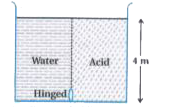 View Solution
View SolutionQuestion 65
A manometer reads the pressure of a gas in an enclosure as shown in figure (a) When a pump removes some of the gas , the manometer reads as in figure (b). The liquid used in the manometers is mercury and the atmospheric pressure is 76 cm of mercury.
(a) Give the absolute and gauge pressure of the gas in the enclosure for cases (a) and (b) , in units of cm of mercury.
(b) How would the levels change in case (b) if 13.6 cm of water (immiscible with mercury) are poured into the right limb of the manometer ? (Ignore the small change in the volume of the gas).
 View Solution
View SolutionQuestion 66
Two vessels have the same base area but different shapes . The first vessel takes twice the volume of water that the second vessel requires to fill upto a particular common height . Is the force exerted by the two water on the base of the vessel the same in the two cases ? If so , why do the vessels filled with water to that same height give different readings on a weighing scale ?View SolutionQuestion 68
In deriving Bernoulli's equation , we equated the work done on the fluid in the tube to its change in the potential and kinetic energy. (a) What is the largest average velocity of blood flow in an artery of diameter 2×10−3m if the flow must remain laminar ? (b) Do the dissipative force become more important as the fluid velocity increases ? Discuss quanlitatively .View SolutionQuestion 71
In Millikan's oil drop experiment , what is the terminal speed of an uncharged drop of radius 2.0×10−5m and density 1.2×103kgm−3 . Take the viscosity of air at the temperature of the experiment to be 1.8×10−5 Pa.s . How much is the viscous force on the drop at that speed ? Neglect buoyancy of the drop due to air .View SolutionQuestion 72
Mercury has an angle of contact equal to 140∘ with soda lime glass . A narrow tube of radius 1.00 mm made of this glass is dipped in a trough containing mercury .By what amount does the mercury dip down in the tube relative to the liquid surface outside ? Surface tension of mercury at the temperature of the experiment is 0.465Nm−1 . Density of mercury =13.6×103kgm−3View SolutionQuestion 73
Two narrow bores of diameters 3.0 mm and 6.0mm are joined together to form a U- tube open at both ends . If the U- tube contains water , what is the difference in its levels in the two limbs of the tube ? Surface tension of water at the temperature of the experiment is 7.3×10−2Nm−1 . Take the angle of contact to be zero and density of water to be 1.0×103kgm−3(g=9.8ms−2).View SolutionQuestion 74
It is known that density ρ of air decreases with height y as
−y/y0
ρ=ρoe
where ρo=1.25kgm−3 is the density at sea level and yo is a constant . This density variation is called the law of atmospheres. Obtain this law assuming that the temperature of atmosphere remains a constant (isothermal conditions).Also assume that the value of g remains constant.
(b) A large He balloon of volume 1425m3 is used to lift a payload of 400 kg . Assume that the balloon maintains constant radius as it rises . How high does it rise ? (yo=8000mandρHe=0.18kgm−3).View SolutionQuestion 75
As shown in the figure two cylindrical vessels A and B are interconnected . Vessel A contains water up to 2m height and vessel B contains kerosene . Liquids are separated by movable, airtight disc C . If height of kerosene is to be maintained at 2m , calculate the mass to be placed on the piston kept in vessel B. Also calulate the force acting on disc C due to this mass. Area of piston =100cm2, area of disc
C=10cm2 , Density of water =103kgm−3, specific density of kerosene =0.8.
 View Solution
View SolutionQuestion 77
The diameter of one end of a tube is 2 cm and that of another end is 3 cm . Velocity and pressure of water at narrow end are 2ms−1and1.5×105Nm9−2 respectively . If the height differnce between narrow and broad ends is 2.5 m , find the velocity and pressure of water at the broad end .(Density of water is 1×103kgm−3). The narrow end is higher .View SolutionQuestion 78
Water is filled in a container upto height H as shown in the figure . A small hole is board on the surface of a container at the depth h from the surface of water . What will be the distance of a point along the horizontal where the jet of the water strikes the ground ? For which value of h will this distance be maximum ? Also find this maximum distance.
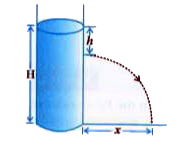 View Solution
View SolutionQuestion 79
The velocities of cylindrical layers of liquid flowing through a tube , situated at distances 0.8cmand0.82cm from the axis of the tube are 3cms−1and2.5cms−1 respectively . Find the viscous force acting between these layers , if the length of the tube is 10 cm and the coefficient of viscosity of the liquid is 8 poise . View SolutionQuestion 85
Water is flowing through a horizontal pipe of irregular cross section . If the pressure at a point where the velocity is 0.2ms−1 is 30 mm Hg , what will be the pressure at a point where the velocity is 1.2ms−1 ? (Density of mercury =13.6gcm−3,g=1000cms−2 , Density of water =1gcm−3)View Solution
All Exercises from KUMAR PRAKASHAN KENDRA PHYSICS (GUJRATI ENGLISH) Class 11 PHYSICS MECHANICAL PROPERTIES OF FLUIDS
- SECTION-A
- SECTION-A TRY YOURSELF (VSQS)
- SECTION - B NUMERICAL FROM DARPAN BASED ON TEXTBOOK
- SECTION - B NUMERICAL FROM TEXTUAL EXERCISE
- SECTION - B NUMERICALS
- SECTION -C (OBJECTIVE QUESTIONS) (VSQS)
- SECTION -C (OBJECTIVE QUESTIONS) (VSQS) ASSERTION AND REASON TYPE QUESTIONS
- SECTION -C (OBJECTIVE QUESTIONS) (VSQS) FILL IN THE BLANK
- SECTION -C (OBJECTIVE QUESTIONS) (VSQS) MATCH TYPE QUESTIONS
- SECTION - (D NCERT EXEMPLAR SOLUTION)
- SECTION - (D NCERT EXEMPLAR SOLUTION) (LONG ANSWER TYPE QUESTIONS
- SECTION - (D NCERT EXEMPLAR SOLUTION) (SHORT ANSWER TYPE QUESTIONS
- SECTION - (D NCERT EXEMPLAR SOLUTION) (VERY SHORT ANSWER TYPE QUESTIONS
- SECTION - E (MCQS)
- SECTION - F (QUESTIONS FROM MODULE)
- QUESTION PAPER (SECTION -A)
- QUESTION PAPER (SECTION -B)
- QUESTION PAPER (SECTION -C)

